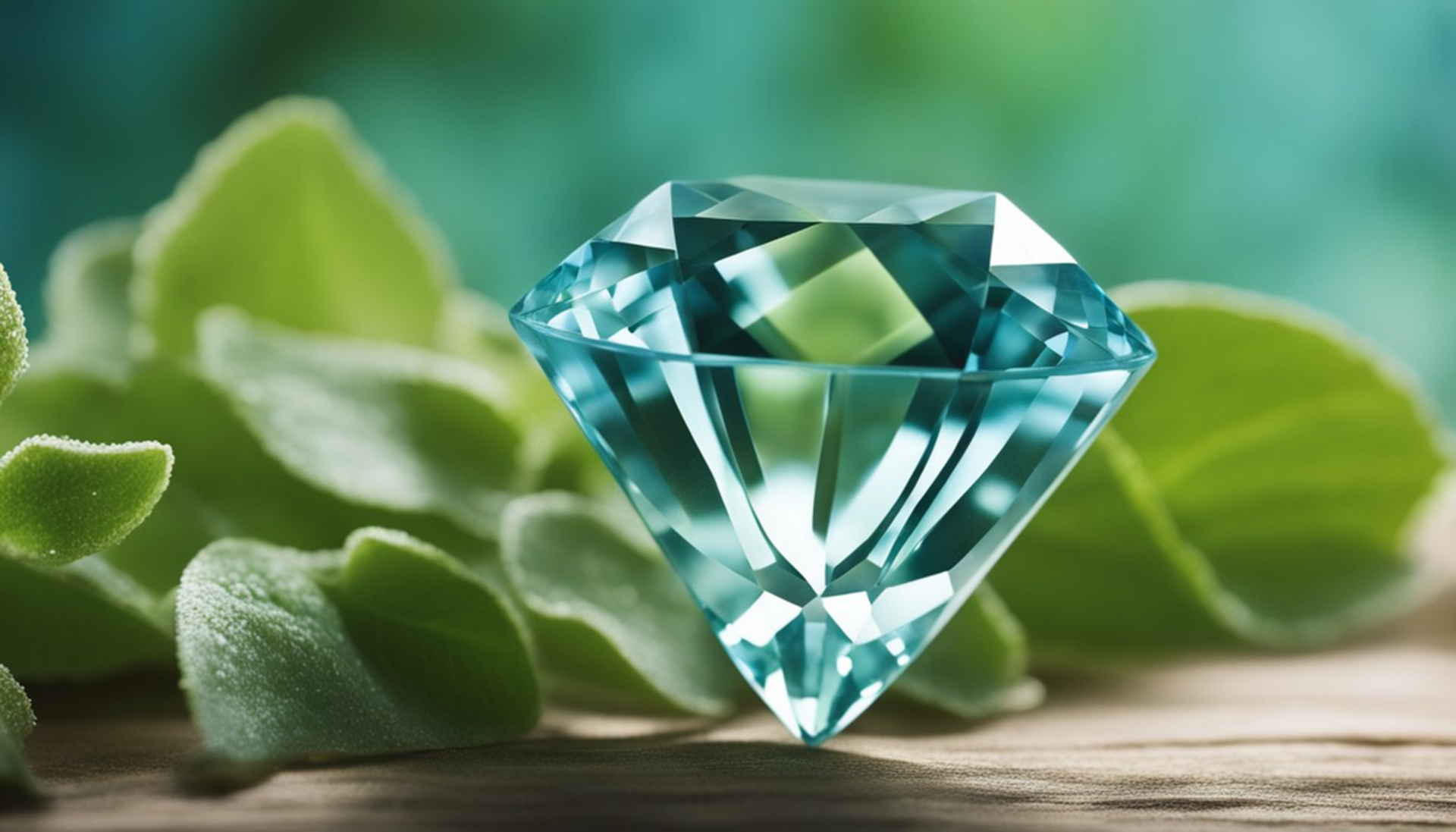Two gemstones for those born in March represent their birth month: aquamarine and bloodstone. Each stone carries a unique history and symbolism that resonates with the qualities long associated with this time of year.
Aquamarine, with its tranquil blue hue, is said to embody the purity of crystalline waters and the relaxation of the sea. It is often connected with feelings of serenity and the soothing qualities of water.
In contrast, bloodstone presents an entirely different appeal with its distinctive dark green color speckled with vivid red spots, reminiscent of blood drops. Known as the warrior’s stone, bloodstone is believed to possess strength, health, and vitality attributes. It is considered a grounding stone, steeped in lore and tradition, and often associated with courage and resilience.
The Significance of Birthstones
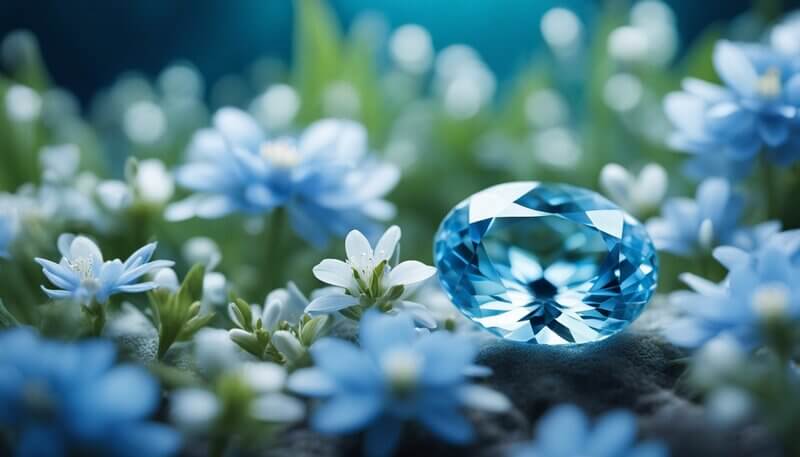
Birthstones are gemstones that represent a person’s birth month, each with unique meanings and historical significance. They are often worn as jewelry and are thought to bring various benefits to the wearer.
Historical Lore and Beliefs
In ancient times, birthstones were believed to hold magic powers and were linked with particular months of the year for heightened potency.
The tradition of associating gems with months dates back to biblical times. The breastplate of Aaron was described as being adorned with twelve stones representing the twelve tribes of Israel. This connection translated over time into the assignment of a stone to each month of the year and, by extension, to those born within those months.
March, for example, has two primary birthstones: aquamarine and bloodstone. These stones are steeped in lore and legend.
With its sea-water hues, Aquamarine was believed by sailors to offer protection on ocean voyages and is thought to symbolize purity, health, and calmness. On the other hand, Bloodstone is historically famed for its alleged healing powers and ability to enhance strength and vitality.
Modern Associations
In contemporary contexts, birthstones such as those for March often carry significance beyond their historical lore.
Today, aquamarine and bloodstone are appreciated for their beauty and are considered ideal gifts for wedding anniversaries or as tokens of love and affection.
The link to a person’s birth month imbues the stones with a personal touch, often signifying intellect and a healthy soul.
Aquamarine is touted for embodying the qualities of serenity and protection, while bloodstone is associated with courage, survival, and guiding decision-making.
Besides personal use, birthstones are popularly incorporated into jewelry designs for their aesthetic properties and supposed healing and magic attributes, making them sought-after gifts that claim to resonate with a person’s inner powers and strength.
Aquamarine: A Sea of Blue

Aquamarine, a gemstone that mirrors the blue tranquility of the ocean, is coveted for its range of blue hues and remarkable clarity. This gemstone captures the essence of the sea and boasts a robust composition that endears it to both jewelers and collectors.
Featured Partner Offer
Color and Appearance
Aquamarines are celebrated for their blue to greenish-blue colors, a trait that resonates with their name, which means ‘water of the sea.’
The color of aquamarine can vary from a light pastel blue to a more intense blue-green; this variation occurs naturally and is affected by iron within the beryl crystal structure.
A high degree of transparency and minimal inclusions contribute to the quality and value of the gemstone.
Geological Properties
Aquamarine is a variety of beryl, a mineral of beryllium aluminum cyclosilicate.
The gemstone’s hardness ranks at 7.5 to 8 on the Mohs scale, indicating good durability for everyday wear. The crystal system is hexagonal, and the iron content gives aquamarine its desirable color.
Mining and Origins
Brazil is renowned for its aquamarine mines, but the stone is also found in Pakistan, Nigeria, Mozambique, Madagascar, the United States, and Zambia.
Each location produces aquamarine with unique qualities, varying in hue, tone, and saturation, from deep blue to lighter blue-green shades.
The quest for aquamarine spans the globe, reflecting the universal allure of its sea-inspired hues and the geological processes that give rise to its formation.
Bloodstone: The Warrior’s Stone
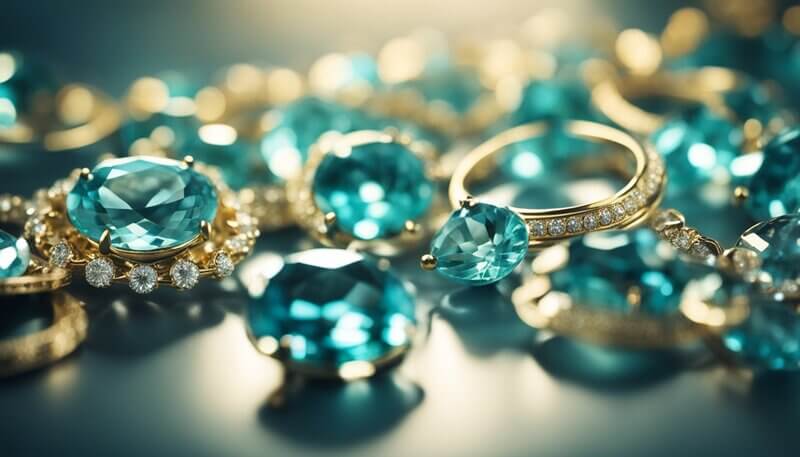
Bloodstone, synonymous with strength and vitality, embodies the warrior spirit. Its deep green hues, interlaced with vivid red echo the power and courage that have long been associated with this gemstone.
Color and Varieties
Bloodstone, also known as heliotrope, is a form of chalcedony, a cryptocrystalline form of quartz.
Its signature look is a dark green backdrop generously sprinkled with spots of red, attributed to the presence of iron oxide. Variations in this gemstone arise mainly from the size and distribution of the red markings, creating a range that boasts subtle to bold patterns.
Historical and Cultural Context
The historical persona of Bloodstone is steeped in legend and mystique.
Since ancient times, it has been held in high esteem for its supposed protective and healing properties.
Warriors and soldiers favored bloodstone, believing it to bring courage and strength in battle. It was also revered as a magical healing stone among ancient civilizations, touted to staunch bleeding and offer vitality to the wearer.
Physical Properties and Care
Bloodstone is 6.5 to 7 on the Mohs scale in terms of hardness, which testifies to its durability.
The purity of a bloodstone is evident through its translucent to opaque sheen.
As with all gemstones, proper care will maintain the stone’s condition; bloodstones should be kept away from harsh chemicals and stored separately to avoid scratches.
Treatment is rare, but it may include sealing to enhance luster. Use only mild soap and warm water when cleaning, and avoid temperature extremes.
Gemstone Quality and Valuation
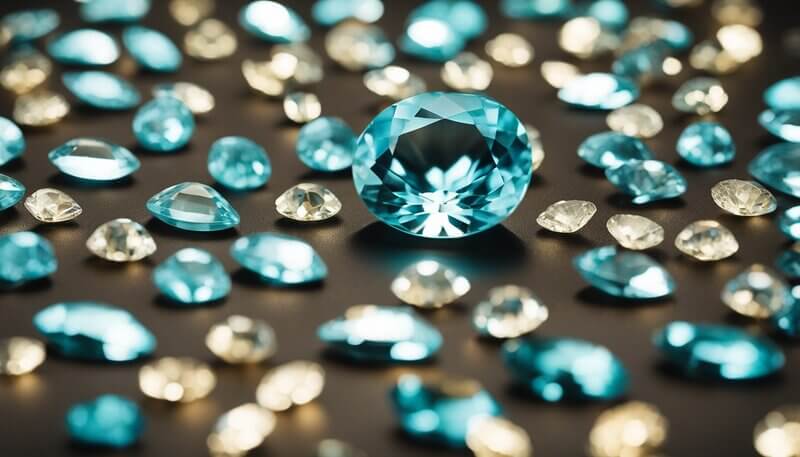
When evaluating March birthstones, color, clarity, carat, and cut factors significantly affect their quality and price. Treatment and certification also play critical roles in establishing market value and authenticity.
Assessing Quality
The quality of an aquamarine gemstone is primarily determined by its color and clarity.
The desirable color range includes shades from pale blue to a deeper blue, sometimes with a slight greenish hue.
Clarity is another critical factor, with fewer inclusions signifying higher quality.
Aquamarines are often expected to be nearly eye-clean, meaning that any inclusions are not visible to the naked eye. The cut of the gemstone, especially if faceted, can enhance the stone’s color and overall brilliance, making cut quality pivotal in assessment.
Understanding Pricing
The price of aquamarine can vary dramatically based on the aforementioned quality factors.
Deep, intense blue aquamarines command higher prices than stones with high clarity.
The size, measured in carats, also affects pricing—larger stones with high purity and minimal treatment are usually more valuable.
Rarity and demand can drive up costs, while the affordability of smaller or lesser quality specimens makes them appealing to a broader market.
Treatments such as heat can improve color but may reduce a stone’s value if not disclosed.
Certificates and Authenticity
To ensure consumer trust, aquamarine gemstones often come with certification from reputable labs confirming their quality attributes and any treatments they have undergone.
Certificates typically include details about the stone’s transparency, purity, and overall quality, providing additional assurance and justification for pricing. Buyers should insist on proper certification to verify the authenticity of their purchase.
Jewelry and Adornment
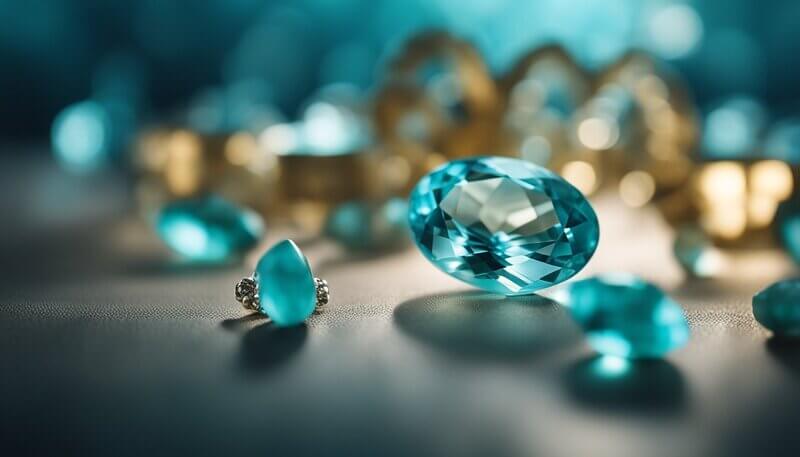
When it comes to March birthstone jewelry, selecting high-quality aquamarine gemstones, understanding their maintenance, and opting for custom pieces can transform adornment into a personal statement.
Selecting the Right Gemstone for Jewelry
When selecting aquamarine for jewelry, one should consider the clarity and color intensity of the gemstone.
Aquamarine, ranging from blue to greenish-blue, is most valuable when it exhibits a deep and vibrant color.
Rings and earrings made with high-quality aquamarine set in gold or silver can provide striking pieces that stand out for their beauty and craftsmanship.
Gemstone Maintenance and Care
Like all gemstones, aquamarine requires proper care to maintain its luster and durability. Regular cleaning with mild soap and warm water is recommended. It should be stored separately to avoid scratches. Jewelry containing aquamarine should not be exposed to harsh chemicals or extreme temperatures to prevent any treatment from being compromised.
Custom and Handmade Pieces
Custom design and handcrafted jewelry allow unique and personal adornments tailored to individual tastes. These pieces can range from minimalist rings to intricate earrings, often becoming treasured gifts. Choosing handcrafted jewelry means investing in something that is exclusive and has a story and an artisan’s touch behind it.
March Birthstone in Culture and Media
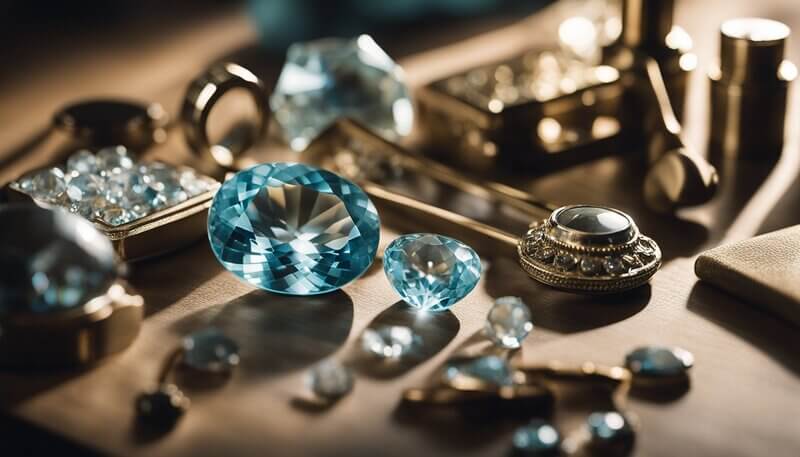
The March birthstones, aquamarine, and bloodstone hold various positions in culture and media. They are featured in literary references to museum exhibits, reflecting their enduring allure and symbolic meanings.
Gemstones in Literature and Film
Aquamarine and Bloodstone, the two primary March birthstones, have captured the imagination of artists and creators. They appear in diverse forms within literature and film. Aquamarine, for instance, is often associated with themes of tranquility and the sea, symbolizing a sense of calm and clarity. This gemstone is sometimes used as a motif to represent serenity and truth in literature. In popular culture, films like “Aquamarine,” where the gemstone plays a pivotal role in the plot, showcase the stone’s enduring mythic appeal.
Famous Collections and Exhibits
Museums and private collections worldwide treasure March birthstones for their beauty and cultural significance. Renowned exhibitions have been known to feature aquamarine gems for their size and pristine clarity. For example, the Smithsonian National Museum of Natural History houses an impressive collection of aquamarines, drawing enthusiasts and scholars alike. Private collectors also prize rare specimens of bloodstone and aquamarine, often loaning them out for temporary exhibits to share their magnificence with the public.
Gemstone Symbolism in Socio-Cultural Movements
The symbolism of March birthstones extends into socio-cultural movements. The aquamarine has been a symbol of youth, health, and hope. Bloodstone, on the other hand, with its distinctive red spots, has historically been tied to courage and sacrifice. It has been employed as a representation of strength in socio-cultural gatherings and movements. Such vibrant colors and rich lore add meaning to these gemstones, elevating their status beyond mere adornments to powerful cultural symbols.
Sourcing and Ethical Considerations
When discussing the March birthstones of aquamarine and bloodstone, it’s essential to consider the ethical implications of their sourcing. This extends to the environmental impact of mining, the labor practices involved in their extraction and trade, and the sustainability measures taken by the gemstone industry.
Responsible Mining Practices
Mining for gemstones such as aquamarine and bloodstone carries environmental risks. Responsible mining practices are crucial to minimize habitat destruction and pollution. The industry must navigate these concerns by adhering to guidelines that prevent undue damage. For instance, minimizing the use of heavy machinery can reduce soil erosion around mining sites.
Labor and Trade Issues
The extraction and sale of birthstones entail complex labor and trade issues. Child labor and forced labor are serious concerns, mandating strict ethical sourcing policies to protect workers’ rights. In regions where bloodstone is prevalent, like India and Brazil, ethical trade practices must be upheld to ensure fair compensation and safe working conditions.
Sustainability and the Gemstone Industry
Sustainability in the gemstone industry pertains not only to environmental conservation but also to sustaining livelihoods. The long-term viability of gemstone resources requires comprehensive sustainable practices, from extraction to the final product’s sale. The sector is urged to invest in closed-loop systems and to promote fair trade to ensure that future generations can enjoy gemstones such as aquamarine without compromising the well-being of current communities and ecosystems.
Frequently Asked Questions
This section provides insightful details about the various facets of March birthstones, helping to expand the understanding of their significance, variations, and historical context.
1. What is the significance of the March birthstone?
March’s birthstones, aquamarine and bloodstone, symbolize courage, health, and calmness. Many believe aquamarine promotes mental clarity, while bloodstone is associated with strength and well-being.
2. What varieties of jewelry typically feature the March birthstone?
The March birthstones are commonly set in various jewelry, including rings, earrings, pendants, and bracelets. Aquamarine is favored for its clarity and is often cut into many shapes, while bloodstone’s rich colors lend a unique look to statement pieces.
3. What color variations do March birthstones exhibit?
Aquamarine ranges from a light greenish-blue to a deep blue, while bloodstone primarily displays a dark green color with flecks of red. Aquamarine is typically more saturated in larger stones, and the presence of iron gives it its blue hue.
4. How do the properties of aquamarine and bloodstone differ as March birthstones?
Aquamarine is a variety of beryl with a glass-like luster and good hardness, making it resistant to scratches. On the other hand, Bloodstone is a form of chalcedony. It is prized for its unique appearance with red spots of iron oxide, giving it an entirely different look than the transparent aquamarine.
5. Which birthstone is commonly associated with the zodiac sign Pisces for March-born individuals?
Bloodstone is commonly linked to the zodiac sign Pisces. It’s said that those born under Pisces in March can benefit from the stone’s healing and protective properties.
6. What historical or cultural significance does the March birthstone have according to biblical references?
Historically, bloodstones are renowned for their significance in Christianity. They are believed to be the stones beneath the cross during Christ’s crucifixion, where drops of blood fell. They are also mentioned in the biblical description of the Breastplate of Aaron, which has twelve stones representing the tribes of Israel.

